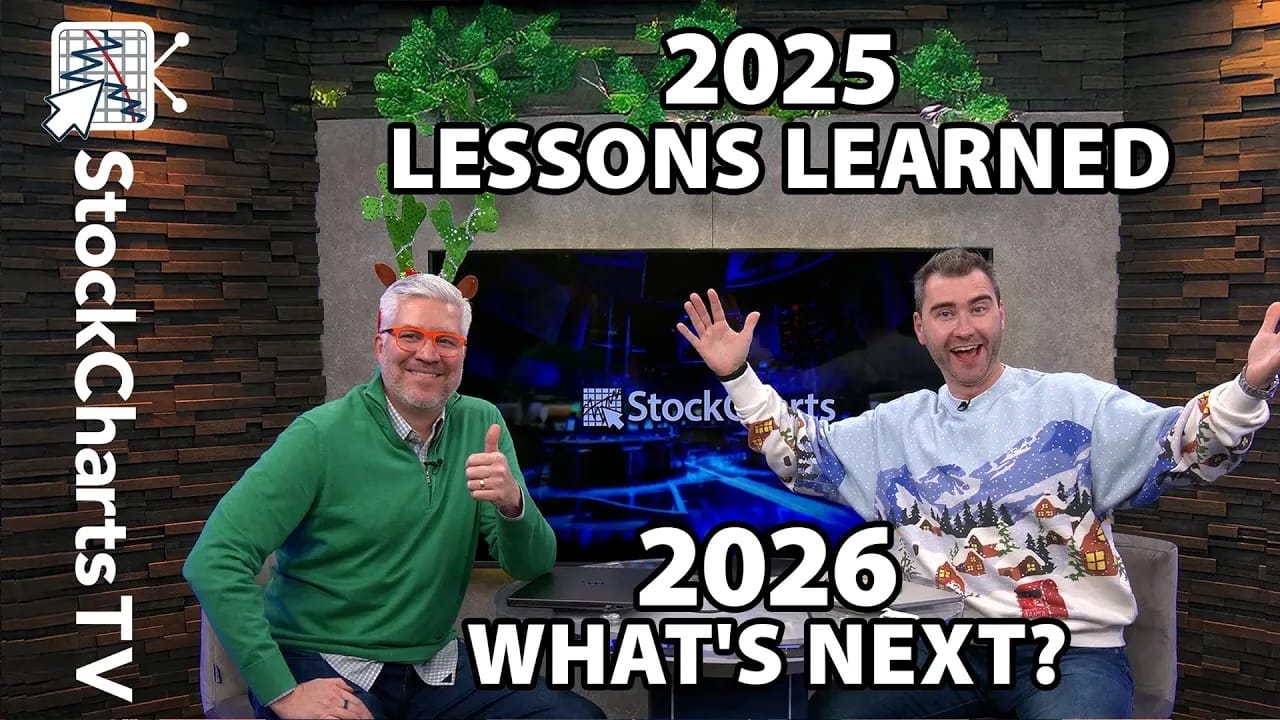DIA AND IWM STALL AFTER BIG MOVES -- REVIEWING DIFFERENT HEAD-AND-SHOULDERS PATTERNS -- QQQ TRACES OUT INVERSE HEAD-AND-SHOULDERS PATTERN -- RETAIL HOLDRS HITS 52-WEEK HIGH WITH STRONG SCTR -- WAL-MART AND HOME DEPOT POWER RTH HIGHER
DIA AND IWM STALL AFTER BIG MOVES... Link for todays video. The stock market appears to be holding its breadth as the European summit and European Central Bank (ECB) policy statement loom later this week. The late November surges are holding, but resistance levels are coming into play. The Dow Industrials SPDR (DIA) and the Russell 2000 ETF (IWM) surged in late November and met resistance in early December. Chart 1 shows DIA moving from 112 to 120 (7.1%) in just three days and then stalling in the 120-122 area the last five days. Resistance here stems from the late October and early November highs. For now, the late November surge is holding and the ETF has yet to reverse off resistance. This means the cup is still half full. A resistance breakout would argue for further strength towards the summer highs (126). A move back into the gap zone would provide the first sign of a failure at resistance.

(click to view a live version of this chart)
Chart 1
Chart 2 shows IWM surging to 74 and then stalling the last five days. Notice how the last five candlesticks have small bodies. A candlestick body is based on the open-close range. Small bodies indicate little change from open to close, which basically signifies indecision. IWM formed doji on Monday and Tuesday. These candlesticks look like plus signs or crosses. Doji can sometimes foreshadow a reversal. After all, indecision is often the first step to a directional change. For now, we have yet to get any short-term signs of a bearish reversal. A sharp move below 72 would reinforce resistance and put the bears back in control of the short-term trend.

(click to view a live version of this chart)
Chart 2
REVIEWING THE DIFFERENT TYPES OF HEAD-AND-SHOULDERS PATTERNS... Head-and-Shoulders patterns can signal trend continuations or reversals. It depends on where they form. A normal Head-and-Shoulders pattern after an advance would be a bearish reversal pattern, while a normal Head-and-Shoulders after a decline would be a continuation pattern. Notice that both of these patterns are bearish. Chart 3 shows four different examples. An inverse Head-and-Shoulders pattern after a decline would be a bullish reversal pattern, while an inverse Head-and-Shoulders pattern after an advance would be a continuation pattern. Both of these patterns are bullish. In reality, a Head-and-Shoulders pattern is just one big consolidation. Once it forms, chartists mark support or resistance based on the neckline. These patterns are ultimately confirmed with a support or resistance break.

(click to view a live version of this chart)
Chart 3
QQQ TRACES OUT INVERSE HEAD-AND-SHOULDERS PATTERN... Chart 4 shows the Nasdaq 100 ETF (QQQ) with a potential inverse Head-and-Shoulders pattern taking shape the last 6-8 months. As a bullish continuation pattern, a break above the 2011 highs would signal a continuation higher and target a move to the upper 60s. Thus far, the right shoulder has yet to make it to resistance. This means it is still a work in progress. A move to resistance would fill out the pattern. A break above resistance would confirm the pattern. Without confirmation, this pattern is just one big consolidation. Notice that the left shoulder extends from January to July. It is also possible that we will see an extended right shoulder, which would make the pattern more symmetrical. A similar extension of the right shoulder would mean a trading range until spring 2012.

(click to view a live version of this chart)
Chart 4
For those not buying this inverse Head-and-Shoulders pattern, note that the trend since the August low is up for QQQ. The ETF formed higher lows in early October and late November. QQQ also formed a higher high with the October break above the September high. Long-term, I would mark support at the late November low. A move below this level would forge a lower low and reverse this uptrend.
RETAIL HOLDRS HITS 52-WEEK HIGH WITH STRONG SCTR... The Retail HOLDRS (RTH) remains one of the strongest ETFs as it challenges resistance from the 2011 highs. Not many stocks or ETFs can make that claim. Chart 5 shows RTH moving above is May-July highs with a surge that began in late November. The ETF poked its head above 114 today to record a new 52-week high. Relative strength in RTH is also confirmed in our new technical rank feature (SCTR) RTH scored a 96.6, which puts it in the top 5% for ETFs covered in the StockCharts Technical Rank (SCTR). Turning back to the price chart, RTH has an inverse Head-and-Shoulders or a cup-with-handle pattern forming. Regardless of the pattern, the resistance breakout shows underlying strength in this ETF. Key support is set at 106 and it would take a break below this level to reverse the uptrend.

(click to view a live version of this chart)
Chart 5
WAL-MART AND HOME DEPOT POWER RTH HIGHER... Wal-Mart (WMT) is the single biggest component of the Retail HOLDRS, accounting for over 18% of the ETF. Chart 6 shows WMT hitting a new 52-week high in early November. After a pullback, the stock surged back to resistance and then consolidated to form a flat flag. A breakout would signal a continuation higher and forge another new high. A move below flag support at 58 would be short-term bearish. We can mark key support at 56. SCTR gives Wal-Mart an 83.2, which puts in the top 20% of the S&P 500.

(click to view a live version of this chart)
Chart 6
Chart 6 shows Home Depot (HD) surging to a new 52-week high on Wednesday. HD Broke above its summer highs in late October and early November. After a pullback in mid November, the stock led the market higher with a 10% surge the last eight days. In fact, notice that HD is up eight days straight. While the stock is short-term overbought, it is clearly in an uptrend and showing leadership. Broken resistance turns into the first support zone to watch in the 36-37 area. SCTR gives HD a 97.20, which puts it in the top 3% of the S&P 500. Users can read more about SCTR (Scooter) in Chips blog post.












